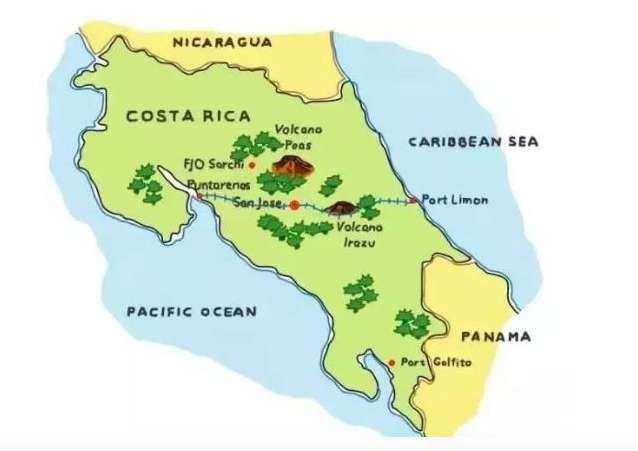Introduction to the History of Costa Rican Coffee producing area what are the characteristics of Costa Rican coffee beans
Costa Rica-while producing coffee, do not forget to set up clean land, pay attention to environmental protection country name: Costa Rica Republic land area: about 51000 square kilometers national population: about 4.7 million people climate: along the coast is a tropical climate, alpine areas belong to habitable temperate climate, climate differences are great

Costa Rica is adjacent to Nicaragua to the north, Panama to the south, the Caribbean to the east and the Pacific to the west. The origin of boutique coffee is mainly concentrated in high altitude areas.
[coffee development] Coffee production began in 1792 when coffee trees were transplanted from Cuba to Costa Rica. Costa Rica is currently the country with the highest standard of living and the highest labor costs in Central America, and coffee beans are also on the rise. [Origin] Tlass, on one side of the Pacific Ocean, 1200-1700m above sea level, is a world-famous coffee producing area, famous for its sour taste and taste. Central Barre, one side of the Pacific Ocean, 1000-1600m above sea level. [representative Manor] La Pilla Manor is a 10-centimeter medium-sized estate located in the Tlass area of high-quality coffee producing area. In Costa Rica, where the processing equipment is generally very advanced, it is very rare to adopt non-washing processing methods. The manor pays great attention to the quality requirements, and the coffee beans produced are of good quality. Pilapi Manor ferments the peel out to produce methane, which is used as a living energy for the manor staff. [harvest time] Coffee in Costa Rica is harvested from November to February of the following year, earlier at lower elevations and until March at higher elevations. [variety] Costa Rican coffee is all Arabica species, and the yield of rust-resistant tree species such as Kaddura and Kaduai is as high as 80%. The planting density of coffee trees is so high that there is almost no shade raw coffee. Especially the Kaddura species, because the height is not more than 2 meters, it is the most widely planted. Kaddura species are planted at higher elevations and Kaduai seeds are planted at lower elevations. [fragrance] Coffee beans from high altitude areas are sour, while those at low altitude are more insipid. Mostly Kaddura, the fragrance is weak, but the stability is good. [grade] Costa Rica determines the grade of coffee according to altitude, origin, sieve size, etc. The altitude of SHB grade was the highest, followed by GHB and HB, and then decreased in turn. Boutique coffee is generally SHB grade, and there are no obvious defects of coffee beans.
Important Notice :
前街咖啡 FrontStreet Coffee has moved to new addredd:
FrontStreet Coffee Address: 315,Donghua East Road,GuangZhou
Tel:020 38364473
- Prev

Flavor characteristics of Beethoven washed coffee beans of Costa Rican musicians series
The coffee beans in Costa Rica are mainly Kaddura and Kaduai. Kaddura and Kaduai have weak aroma but good stability, so Costa Rican coffee beans are often characterized by honey treatment. but washing treatment often better reflects the basic flavor of a region. Today we evaluated the washed coffee beans in the Qianjie Coffee Workshop: Costa Rican musicians.
- Next

Yemeni Coffee Origin introduces Yemeni Coffee aroma Yemeni Coffee Tree species
The country name of the coffee-producing area of Yemen with a long history: the land area of the Republic of Yemen: about 528000 square kilometers of the country population: about 25 million people Climate: most of the land of Yemen is very powerful during the day, cool at night, and there is a large temperature difference between day and night, but there are some exceptions. Coffee cultivation in Yemen has a long history, and Yemenis believe that coffee originated in Yemen. Because the port of Mocha
Related
- Beginners will see the "Coffee pull flower" guide!
- What is the difference between ice blog purified milk and ordinary milk coffee?
- Why is the Philippines the largest producer of crops in Liberia?
- For coffee extraction, should the fine powder be retained?
- How does extracted espresso fill pressed powder? How much strength does it take to press the powder?
- How to make jasmine cold extract coffee? Is the jasmine + latte good?
- Will this little toy really make the coffee taste better? How does Lily Drip affect coffee extraction?
- Will the action of slapping the filter cup also affect coffee extraction?
- What's the difference between powder-to-water ratio and powder-to-liquid ratio?
- What is the Ethiopian local species? What does it have to do with Heirloom native species?

